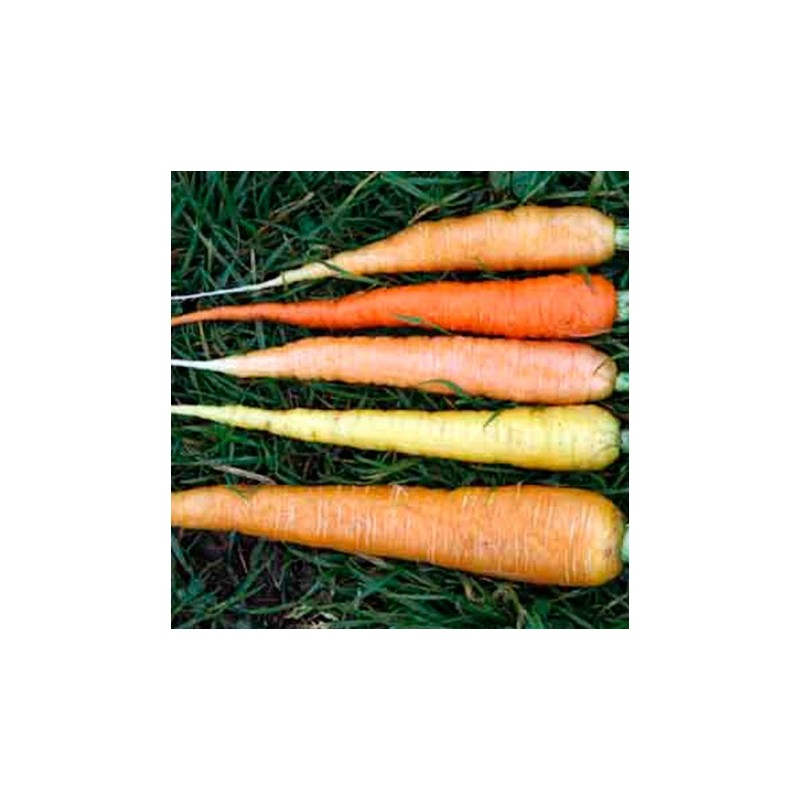



An unusual variety that produces amazing roots from orange to yellow to white. A strong growing variety with healthy and vigorous foliage. Approximately 90 days from sowing to maturity. A mixture of colours will give an extra interest to harvesting your root vegetables. A great carrot to grow for and with kids, just imagine them pulling the carrots up without knowing what colour to except.
Carrot is a common and popular root vegetable, carrots are also fun to grow. Originating in central Asia, carrots originally were purple, red, yellow, and black. The orange carrot we know and love today is a relative newcomer to the carrot scene. Recently, the other, older, color varieties have gained their popularity back. Their seeds are easily found from most seed companies, making them a nice addition in the garden, growing alongside the classic orange ones..
Planting
Because they are a cold weather, hardy crop, carrots are often the first thing to be planted. They can be planted 2-3 weeks before the last frost. Seeds should be planted shallowly, with just 1/2” of soil covering them. Plant them 1-2 inches apart, with 10 -12 inches between each row.
Carrots germinate slowly and need a consistent moist soil to sprout. The top of the soil should not be allowed to get dry, it is true with most veg not just carrots, until the carrot seeds have germinated. Carrots can be slow to come up, but don't be afraid it should be about 3 weeks the most until you see the seedlings. The rule of thumb with watering carrots when they are young is to use less water yet water frequently. Ideally, the soil around them should be watered lightly twice a day, morning and evening.
When the sprouts have grown to about 1-2” tall, they should be thinned vigorously. Because the seeds are so small, it is common, and almost impossible not to, over-plant and have too many seedlings vying for the same space. Carrots need approximately, depending on variety, 1-3 inches between each plant. If they are not thinned enough, you will end up with tiny, thin carrots that are all top and no root. Carrots are best thinned by carefully snipping the tops off the unwanted ones with a small pair of scissors. This reduces the possibility of damage to the delicate seedlings you are going to keep.
Do several plantings of carrots, spacing them out by three weeks, to get a continuous harvest throughout the gardening season.
Soil & Watering
Carrots need deep, loose, well-drained soil that has had any rocks and roots removed from it. Because they grow downwards, anything getting in their way will stunt or prevent their growth. A common problem is branching, which happens when the carrot splits down the middle and tries to grow around whatever is getting in it's way. These are still completely edible, just not as well shaped. Clear the soil out about a half a meter deep, picking out any obstructions, loosening the soil as you go. Hard, compact, soil will cause the carrot roots to fork and be otherwise oddly shaped.
Planting in a place where the carrots will get at least 8 hours sun is best, however because they are a root vegetable, they can also do well in slightly shady spots too.
After the initial consistent watering when the carrots are little seedlings, the plants will do well with less frequent watering. Watering less often with less water encourages longer roots.
Companion Planting
A common growing method is to plant radishes in the same row as carrots. Radishes grow much faster than carrots and will break up and loosen the soil in preparation for the carrot roots. Also, the quick germinating radishes can be a row marker, so you don't forget the carrots are there, since they take so long to sprout.
Varieties
Carrots varieties are decided by the shape and length of their root. Nante variety carrots have medium length roots with a stubby tip. These tend to mature faster than other types and are excellent eaten raw, making them a favorite among home gardeners. Imperator carrots have a small base and slender root which tapers at the tip. Danvers variety carrots are wide at the top and medium in length. These are great for juicing. Chantenay carrots have broad tops and rounded tips.
Pests & Disease
A number of problems can affect a carrot crop. Carrot root flies are maggots that eat the roots and devastate the carrot. If you see any sign of these, the best thing to do is harvest your crop immediately so the maggots don't get the rest. Carrot flies detect the carrot roots by their sweet scent. Planting chives or another strong smelling plant near the carrots can help cover the irresistible carrot aroma.
Harvesting
Carrots can be harvested when they are young or when they are fully mature. Each carrot variety has it's own growth specifications, so make sure to read the seed packet. While they can be eaten early, carrots, if left too long can get woody, tough and bitter, and basically inedible. To find out if your carrots are ready, pull one up!
When you dig up the carrots, if they are not going to eaten soon, cut the leafy tops off to prevent them from wilting during storage.
Carrots can be stored in a cool, dark, space, preferably packed in damp sand or sawdust, for at least 6 months. They are a great vegetable resource during the non-gardening months.